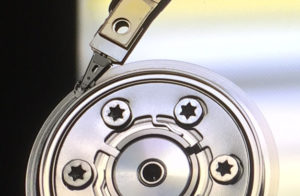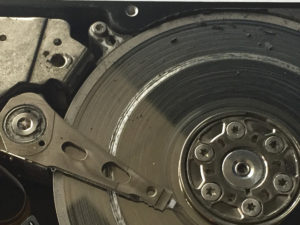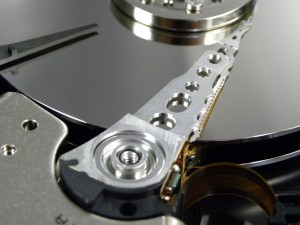
The platters and actuator heads of a hard drive.
Can you recover data if a hard drive’s platters are physically damaged?
Yes — sometimes, depending on the extent of the damage. The success of the recovery depends on the location and severity of the damage, as well as the drive’s model, the size of the targeted files, and other factors.
Any data stored in the physically scratched area is permanently gone. Once the magnetic material that stores your data is disrupted, there’s no way to restore it. However, professional data recovery engineers may be able to retrieve data from the intact portions of the drive.
A scratch on a hard drive platter is a catastrophic physical failure. It occurs when the read/write heads have made direct contact with the platter surface, scraping away the thin magnetic layer that stores your data (a head crash).
Below, we’ll explain more about platter damage, including rotational scoring (and we’ve got a few pictures of severely damaged drives, which should help you understand the basics). If you’ve lost data due to a hard drive failure — or for any other reason — we’re here to help. Schedule a risk-free evaluation by calling 1-800-237-4200 or submitting a ticket online.
Hard Drive Platter Damage: The Basics
On a hard drive, data is stored as magnetic charges on circular disks called platters that spin at thousands of rotations per minute (RPM). The read/write heads fly on a cushion of air just nanometers above the surface of the platters.

This hard drive shows rough platter damage where the head remained in contact with the platters for several hours of operation.
That’s not much room for error.A head crash occurs when this clearance is lost, usually due to a physical shock (like dropping the drive), sudden power loss, or component wear. The head makes contact with the rapidly spinning platter.
Modern drives are designed to limit the potential for this type of damage; when the drive detects an issue with its components, it will often try to move the heads away from the platters. However, hard drives are mechanical — and every mechanical device eventually fails.
A severe head failure can lead to immediate data loss, and operating the drive will cause additional damage. The picture to the right shows what happens when a hard drive operates in a failed state for an extensive amount of time.
But to be clear, running a physically damaged drive for any amount of time may cause permanent data loss. If you notice unusual noises or other signs of physical damage, turn your drive off immediately and contact a professional data recovery provider.
Scratched Hard Drive Platter Data Recovery
Recovering data from a scratched drive is a delicate and complex procedure that can only be performed in a specialized lab environment. All of our locations feature fully equipped laboratories with certified cleanrooms, and all HDDs are treated onsite — we don’t operate mailing offices or outsource any part of the data recovery process.
While the exact techniques vary for each case, here’s an overview of how it works:
- 1. Cleanroom Assessment: We examine the hard drive in a certified cleanroom, a specialized environment prevents airborne dust from causing further platter damage. An engineer will examine the platters under a microscope to determine the extent of the damage and the potential for recovery.
- 2. Internal Component Replacement: The original read/write heads are always destroyed during a crash. They must be replaced with a compatible set from a matching donor drive. Datarecovery.com maintains an extensive hardware inventory with thousands of hard drives, solid-state drives, RAID controllers, and other hardware.
- 3. Platter Cleaning (If Necessary): If the platters are contaminated with debris, our engineers may perform a highly specialized process to remove the particles. Do not attempt to clean platters at home; this is an advanced, last-resort procedure that must be performed in a controlled environment.
- 4. Drive Imaging: Once the drive is mechanically stable, we connect it to a specialized hardware imager. By sending low-level commands to the drive, we can instruct it to read every readable sector and intelligently skip over the damaged areas.
- 5. Logical Reconstruction: After creating the best possible image of the drive, our engineers work with the cloned data. They analyze the raw data to repair the file system and rebuild the files and folder structure.
In cases with severe platter damage, these techniques will not be effective. That’s one of the reasons that we start every case with a risk-free evaluation: If data is permanently destroyed, our clients are not charged for the analysis.
What Is a Partial Data Recovery?
 A partial recovery is the most likely outcome for a drive with scratched platters. The success is determined by what data was physically destroyed.
A partial recovery is the most likely outcome for a drive with scratched platters. The success is determined by what data was physically destroyed.
Because hard drives don’t write data contiguously (in other words, files may be spread across a disk, or fragmented), there’s usually no way to determine what is recoverable simply by assessing the state of the platters.
In many cases, even a partial recovery can be a complete success if it retrieves the user’s most critical files. Our no data, no charge guarantee is based on the files you request: If we’re unable to recover what you need, there’s no charge for the attempt.
If Your Drive Is Clicking or Grinding, Turn It Off
A clicking, scraping, or grinding noise is the classic sign of a head crash. Your actions in the first few seconds are critical:
- Power It Off Immediately: Every moment the drive is powered on, the damaged heads are scraping across the platters, making the damage worse and drastically reducing the chances of a successful recovery.
- Do Not Use Data Recovery Software: Software cannot fix a physical problem. Attempting to run software on a physically failed drive will cause further damage and may make the data unrecoverable. Learn why we discourage the use of data recovery software.
- Do Not Open the Drive: Opening a hard drive outside of a certified cleanroom environment will expose the platters to contaminants and may lower the chances of a successful recovery.
Datarecovery.com provides risk-free evaluations, and our no data, no charge policy ensures you only pay if we recover what you need.
If you have a clicking or physically damaged hard drive, contact our experts at 1-800-237-4200 for a free consultation or submit a case online.




